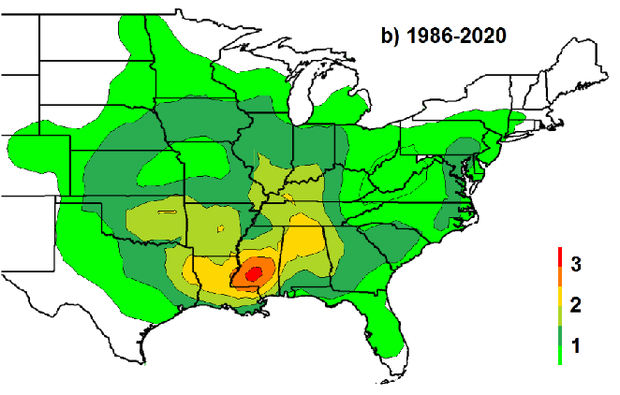There is growing evidence that “Tornado Alley,” the area of the United States most susceptible to tornadoes, is moving east, according to a recent study analyzing tornado formation patterns.
“Tornado Alley” is a shortened term that typically describes the central plains region of the United States, but according to the to study, published in April in the Journal of Applied Meteorology and Climatology, parts of the eastern US now face the “highest tornado threat.” Tornado activity is now much more likely to impact the Midwest and Southeast, the study said.
The change has been ongoing since 1951, according to the study, which used information from two different data sets, each spanning 35 years, to determine where and when tornadoes formed. The study looked at tornadoes rated F/EF1 or stronger. (A tornado is considered EF1 in Improved Fujita scale if its wind gusts are estimated at 86-110 mph, based on the amount of damage. The scale goes from EF0 to EF5 for the most damaging twisters.)
Maps of patterns of tornadogenesis, or the process by which a tornado forms, show that between 1951 and 1985, tornado formation peaked in north Texas, Oklahoma and Kansas.
Coleman, Thompson and Forbes, 2024, JAMC. © American Meteorological Society. Used with permission. This draft version has been accepted for publication in the Journal of Applied Meteorology and Climatology and can be cited in full. The final edited article will replace the EOR when published.
Another map shows that from 1986 to 2020, tornadogenesis peaked in Mississippi, Louisiana and Alabama. Such events were also increasing further east, including Virginia, West Virginia and Pennsylvania.
Coleman, Thompson and Forbes, 2024, JAMC. © American Meteorological Society. Used with permission. This draft version has been accepted for publication in the Journal of Applied Meteorology and Climatology and can be cited in full. The final edited article will replace the EOR when published.
Tornadoes in the western part of the country decreased by 25% between those two periods, going from more than 8,450 tornadoes between 1951-1985 to just over 6,300 between 1986-2020, the study found. During this same period, tornado activity in the eastern United States increased by 12%, from more than 9,400 tornadoes between 1951-1985 to more than 10,500 tornadoes between 1986-2020.
And it’s not just regions that are changing, according to the study: Tornadoes are increasingly likely to form in colder climates. Earlier this year, Wisconsin saw a tornado in februarya first for the state.
Several deadly tornadoes have hit the U.S. this year, especially in the Plains and Midwest. NOAA confirmed 39 tornado-related deaths this year, including eight in Texas and Oklahoma. On Wednesday, a 2 year old child was killed when a tornado in Michigan caused a tree to fall on a house.
The damage was also visa in Maryland Wednesday from what may be the strongest tornado to hit the D.C. metro area since 1996.
CBS News Senior Weather Producer David Parkinson said late May is typically a very busy time for tornadoes, but explained that of Climate Change may be causing severe storms to occur more frequently.
“We can’t in any way call a tornado something that’s linked to climate change, but we can say that the pattern in which things are getting bigger and stronger is probably related to a warming world,” Parkinson said.
dia das mãe png
globo absoluto
portal de notícias da globo
globo esporte geral
portal de noticias da globo
jornal g1
























